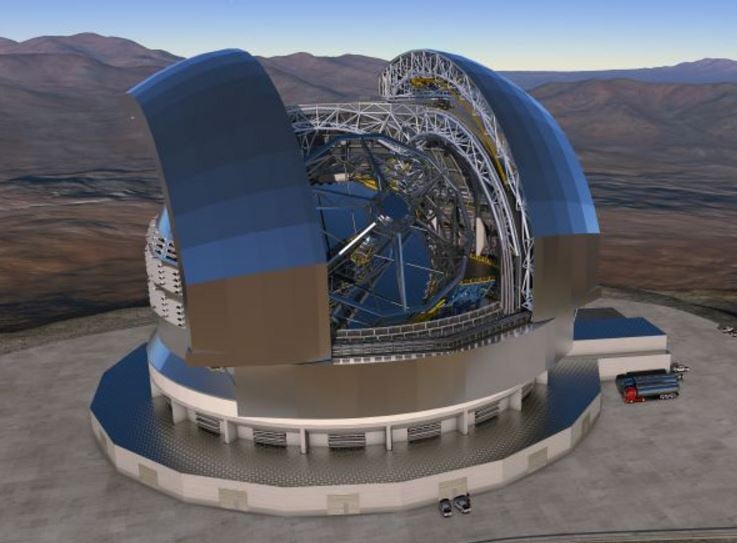Construction has started on the world’s first super telescope, which will bring us a step closer to understanding the inner-workings of our Universe. The first stone was laid last week in a ceremony in Northern Chile, in the Atacama Desert, the world’s driest desert. When completed, the super telescope – called the Extremely Large Telescope (ELT) – will be the world’s largest optical and infrared telescope.
It will have a main mirror 39-metres wide, which as its name suggests will be massive. In this article, the terms Extremely Large Telescope, ELT, and super telescope have the same meaning.
Unlike any telescope before it, ELT will also be an adaptive telescope – it will have the ability to correct turbulence in the atmosphere, thus taking telescope engineering to a completely new level.
 An artist’s impression of the super telescope when construction is completed. ESO wrote: “The ELT will tackle the biggest scientific challenges of our time, and aim for a number of notable firsts, including tracking down Earth-like planets around other stars in the “habitable zones” where life could exist — one of the Holy Grails of modern observational astronomy.” (Image: ox.ac.uk)
An artist’s impression of the super telescope when construction is completed. ESO wrote: “The ELT will tackle the biggest scientific challenges of our time, and aim for a number of notable firsts, including tracking down Earth-like planets around other stars in the “habitable zones” where life could exist — one of the Holy Grails of modern observational astronomy.” (Image: ox.ac.uk)
Super telescope ceremony
To mark the beginning of the construction project, a ceremony was held at the European Southern Observatory’s (ESO’s) Paranal residencia in northern Chile, very near to where the ELT will be built – on top of the Cerro Armazones, a mountain peak 3,046 metres high.
The mountain top is a privileged zone for optical astronomy, because it has on average 89% cloudless nights a year.
The ceremony was attended by the President of the Republic of Chile, Michelle Bachelet Jeria, Tim de Zeeuw, Director General of the ESO, and other lawmakers, scientists, and ESO personnel.
The super telescope is being built by the European Southern Observatory, an international collaboration supported by the United Kingdom’s Science and Technology Facilities Council (STFC).
 According to ESO: “HARMONI, or the High Angular Resolution Monolithic Optical and Near-infrared Integral field spectrograph, will be the first instrument installed on the European Extremely Large Telescope (E-ELT) and will function as the telescope’s workhorse instrument for spectroscopy in the wavelength range 0.5–2.4 µm. The picture above shows a sectional view of HARMONI and its size in comparison with a man.” (Image: eso.org. Credit: HARMONI Consortium)
According to ESO: “HARMONI, or the High Angular Resolution Monolithic Optical and Near-infrared Integral field spectrograph, will be the first instrument installed on the European Extremely Large Telescope (E-ELT) and will function as the telescope’s workhorse instrument for spectroscopy in the wavelength range 0.5–2.4 µm. The picture above shows a sectional view of HARMONI and its size in comparison with a man.” (Image: eso.org. Credit: HARMONI Consortium)
HARMONI spectograph
Scientists from Oxford University are responsible for the design and construction of the super telescope’s spectrograph, called HARMONI. HARMONI stands for High Angular Resolution Monolithic Optical and Near-infrared Integral field.
HARMONI is designed to take 4,000 images simultaneously. Each image has a slightly different colour. The near-infrared and visible instrument will harness the ELT’s adaptive optics to provide amazingly-sharp images.
In a press release, the University of Oxford wrote:
“HARMONI will enable scientists to form a more detailed picture of the formation and evolution of objects in the Universe.”
“Supporting researchers to view everything from the planets in our own solar system and stars in our own and nearby galaxies with unprecedented depth and precision, to the formation and evolution of distant galaxies that have never been observed before.”
HARMONI’s principal investigator, Niranjan Thatte, a Professor of Astrophysics at Oxford’s Department of Physics, said regarding the ELT:
“For me, the ELT represents a big leap forward in capability, and that means that we will use it to find many interesting things about the Universe that we have no knowledge of today.”
“It is the element of ‘exploring the unknown’ that most excites me about the ELT. It will be an engineering feat, and its sheer size and light grasp will dwarf all other telescopes that we have built to date.”
ELT time capsule
During the ceremony, a time capsule created by ESO personnel was sealed. It contains a copy of a book describing the super telescope and its goals, images of ESO staff involved in its construction, and a poster of an ELT visualisation.
The capsule’s cover is engraved in a hexagon made of Zerodur©, a one-fifth scale model of the primary mirror segments of the super telescope.
Regarding what the super telescope will do for science and technology, Tim DE Zeeuw said:
“The ELT will produce discoveries that we simply cannot imagine today, and it will surely inspire numerous people around the world to think about science, technology and our place in the Universe. This will bring great benefit to the ESO member states, to Chile, and to the rest of the world.”
Patrick Roche, President of the ESO Council, added:
“This is a milestone in ESO’s history, the ELT will be the most powerful and ambitious telescope of its kind. We have reached this point thanks to the efforts of many people in the Member States of ESO, in Chile and elsewhere, over many years. I thank them all and am delighted to see many of them here today, celebrating on this occasion.”
If all goes according to plan, the super telescope will be operational in 2024.
Fly inside the ELT! #BiggestEyeOnTheSky https://t.co/xyII8ZiBWg pic.twitter.com/iXikHShgqT
— ESO (@ESO) May 26, 2017
